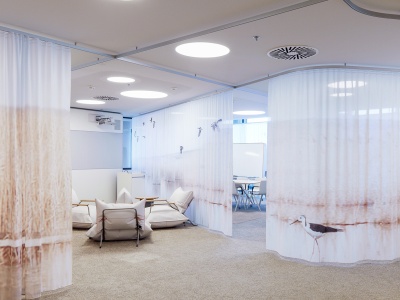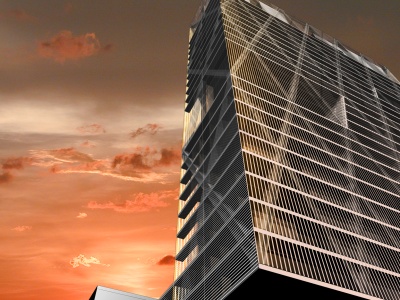THE GRID
REVITALIZING A HISTORIC BUILDING WITH A NEW OFFICE DESIGN AND SPACE PLANNING FOR VERBUND AG IN VIENNA
- Interior Architecture
- Space Planning
- Interior Design
- Lighting Design
- Site Supervision
respecting the context of the site / preservation of the pre-dated structure / historic building / open office / reduced material selection / corporate architecture / company identity / green energy / sustainable building / human-centered design / biophilia / fractals / healthy work environment
The historic palace from 1860 was destroyed during World War II and rebuilt from 1952 to 1955 based on a design by architect Carl Appel. The new construction represents a classic architectural style from the 1950s. Our approach is to view projects holistically, placing people at the center. "Human-centered design" guides all our projects. The goal was to create an area-efficient, open office layout with high demands on room acoustics and quality. Therefore, the intention was to maximize the volume of space. Suspended ceilings were omitted in the open office structures. The increased ceiling area due to the cap ceiling was reinforced with fireproof plaster, which also meets the required sound absorption for the work zones, making the existing building structure tangible in a modern context. In enclosed meeting rooms and smaller offices, a suspended ceiling serves acoustic purposes. The backbone of the design is the so-called Spine, a multifunctional grid-furniture that serves as a room filter along the access zone and allows for various general uses such as creative areas, showcasing, libraries, communication niches, plants, copy & print, and waste disposal. Modules were developed and located in collaboration with employees. Workstations are spatially separated, yet the Spine allows for transparency and visual connection with all other zones, thereby promoting collaborative work and social aspects. Workstations are designed with tall panels for individual, focused work while still enabling direct communication with the surroundings. Tables for collaborative work feature smaller panels solely for acoustic purposes. Hybrid working is facilitated in meeting rooms and phone booths, serving as retreats that exclude communication with the surroundings. These spaces can also be used for video conferences and phone calls. The gathering zone serves as a social hub on the floors, offering various seating options and excellent culinary offerings that encourage employees to linger and support social exchange. "Mission V" utilizes water, wind, and solar energy as primary sources for electricity generation, a concept also applied in our meeting room design. The spatial distribution and heights of themes and furnishings such as lounge, seating, and bar furniture were developed in collaboration with employees. Photographic motifs and furniture were tailored to the theme. In addition to technical requirements, the interior must meet the demands of a new working environment. Room acoustics, lighting, and diverse work options are prerequisites for modern work. Employees must also be prepared for this new environment. The design engages in dialogue with the historic building; the combination and relationship between modern design and historical substance are crucial. Revitalizing a historic building is the most sustainable approach. Compared to new construction, the resource consumption is disproportionate. State-of-the-art, computer-supported building technology ensures a comfortable indoor climate with optimized energy use. Material selection emphasizes ecological footprint alongside spatial quality and material harmony for a pleasant atmosphere. Careful consideration of material decisions is essential. Ultimately, it's about ensuring employees feel comfortable in their work environment, thereby making a significant and sustainable contribution. The fractal patterns on the flooring define the introduction of science-informed biophilic designs for the built environment. The fractal pattern designs, developed by Prof. Dr. Richard Taylor from Fractals Research/University of Oregon and 13&9 Design for Mohawk Group, balance desirable levels of preference and engagement with relaxing and refreshing qualities. The results, published in a special edition on Biophilic Design Rationale in the journal Frontiers in Psychology, show that mid-complexity fractal designs are very effective at balancing engagement, preference, refreshment, and relaxation qualities for a broad group of observers. Specifically, these patterns have the greatest agreement across individuals in terms of their preference, engagement, and refreshment while also maintaining relaxing effects.
- project name: THE GRID
- function: office
- location: Vienna, AUSTRIA
- floor space: 5.300 m²
- number of floors: 3,5
- construction start: 06 / 2023
- completion: 03 / 2024
- project team:
Oliver Kupfner, Jörg Kindermann, Lisa Nett
- photographer: Paul Ott












